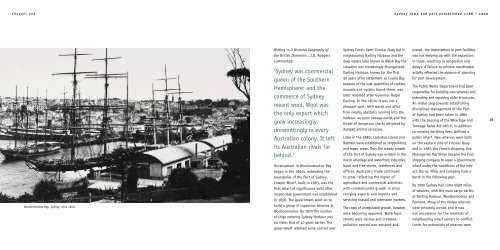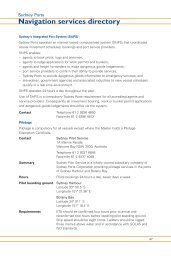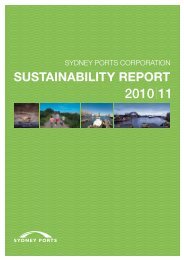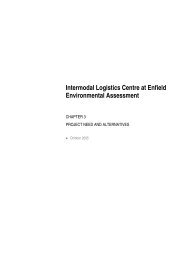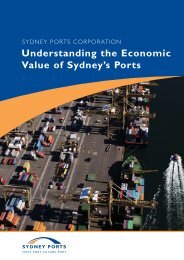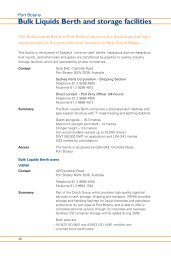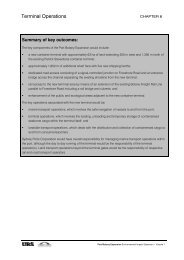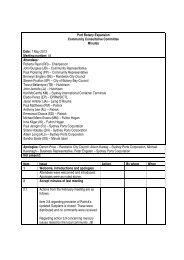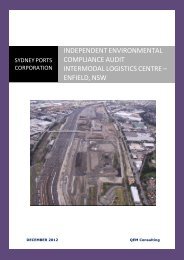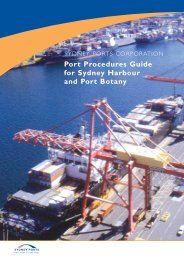Chapter 1..... - Sydney Ports
Chapter 1..... - Sydney Ports
Chapter 1..... - Sydney Ports
Create successful ePaper yourself
Turn your PDF publications into a flip-book with our unique Google optimized e-Paper software.
<strong>Chapter</strong> one<br />
<strong>Sydney</strong> town and port established 1788 – 1900<br />
24<br />
Woolloomooloo Bay, <strong>Sydney</strong>, circa 1900.<br />
Writing in A Historial Geography of<br />
the British Dominions, J.D. Rodgers<br />
commented:<br />
‘<strong>Sydney</strong> was commercial<br />
queen of the Southern<br />
Hemisphere; and the<br />
commerce of <strong>Sydney</strong><br />
meant wool. Wool was<br />
the only export which<br />
grew increasingly,<br />
unremittingly in every<br />
Australian colony. It left<br />
its Australian rivals far<br />
behind.’<br />
Development in Woolloomooloo Bay<br />
began in the 1860s, extending the<br />
boundaries of the Port of <strong>Sydney</strong>.<br />
Cowper Wharf, built in 1863, was the<br />
first wharf of significance built after<br />
responsible government was established<br />
in 1856. The government went on to<br />
build a group of capacious wharves at<br />
Woolloomooloo. By 1870 the number<br />
of ships entering <strong>Sydney</strong> Harbour was<br />
six times that of 40 years earlier. The<br />
government retained some control over<br />
<strong>Sydney</strong> Cove’s Semi-Circular Quay but in<br />
neighbouring Darling Harbour and the<br />
deep waters later known as Walsh Bay the<br />
situation was increasingly disorganised.<br />
Darling Harbour, known for the first<br />
40 years after settlement as Cockle Bay<br />
because of the vast quantities of cockles,<br />
mussels and oysters found there, was<br />
later renamed after Governor Ralph<br />
Darling. In the 1870s it was not a<br />
pleasant spot, with waste and offal<br />
from nearby abattoirs running into the<br />
harbour, an open sewage outlet and the<br />
threat of dangerous sharks attracted by<br />
dumped animal carcasses.<br />
Later in the 1880s Cockatoo Island and<br />
Balmain were established as shipbuilding<br />
and repair areas. Thus the steady growth<br />
of the Port of <strong>Sydney</strong> was evident in the<br />
rise in wharfage and waterfront industries,<br />
bond and free stores, residences and<br />
offices. Australia’s trade continued<br />
to grow, reflecting the vigour of<br />
agriculture and commercial activities,<br />
with commensurate growth in ships<br />
carrying exports and imports and<br />
servicing coastal and interstate markets.<br />
The costs of unregulated growth, however,<br />
were becoming apparent. Waterfront<br />
streets were narrow and cramped,<br />
pollution control non-existent and,<br />
overall, the improvement in port facilities<br />
was not keeping up with the expansion<br />
in trade, resulting in congestion and<br />
delays. A failure to achieve coordinated<br />
activity reflected the absence of planning<br />
for port development.<br />
The Public Works Department had been<br />
responsible for building new wharves and<br />
extending and repairing older structures.<br />
An initial step towards establishing<br />
disciplined management of the Port<br />
of <strong>Sydney</strong> had been taken in 1880<br />
with the passing of the Wharfage and<br />
Tonnage Rates Act which, in addition<br />
to revising berthing fees, defined a<br />
public wharf. New wharves were built<br />
on the eastern side of Circular Quay<br />
and in 1883 the French shipping line<br />
Messageries Maritimes became the first<br />
shipping company to lease a government<br />
wharf under the conditions of the new<br />
act. Burns, Philp and Company took a<br />
berth in the following year.<br />
By 1900 <strong>Sydney</strong> had some eight miles<br />
of wharves, with the main cargo berths<br />
at Darling Harbour, Woolloomooloo and<br />
Pyrmont. Many of the timber wharves<br />
were privately owned and it was<br />
not uncommon for the interests of<br />
neighbouring wharf owners to conflict.<br />
Limits for extensions of wharves were<br />
25


